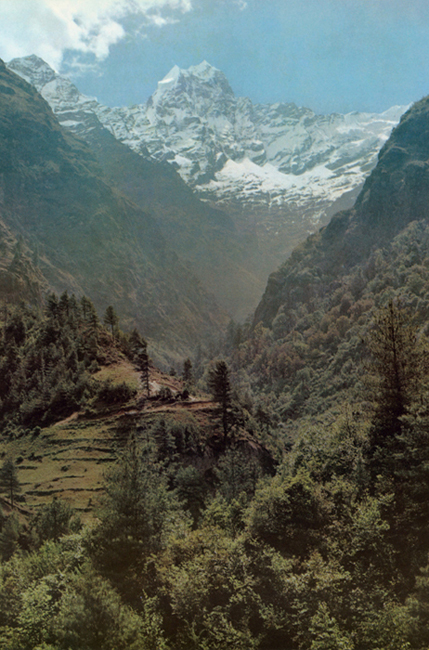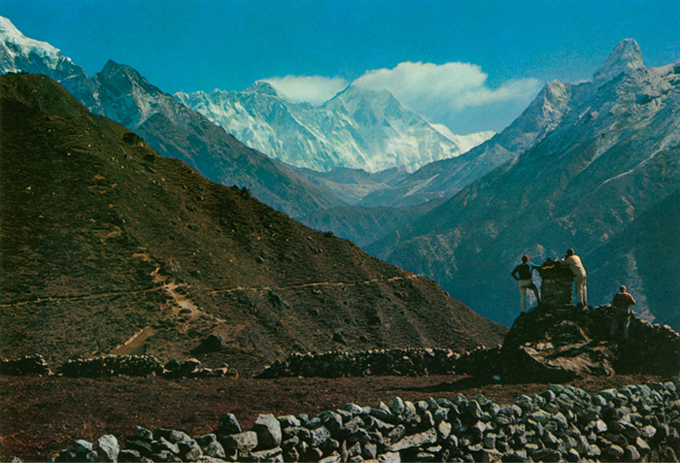—W.H. MURRAY
—W.H. MURRAY
At Puijan, mist clung to the trees, trapping the damp cold that had sent the rest of the team off to bed. Jake and I sat astride a log, facing each other, and Lute balanced on a stump on the other side of the fire, his sunburnt face glowing redder in the dancing light. Jake had doubts about altitude. Would he be able to hack it high on the West Ridge? Looking at him, I saw myself approaching Masherbrum three years before. I was unsure, a bit afraid then, more confident now, and told him: “I think most people adapt pretty well, as long as they don’t get sick. Some come on a little slower than others, like Dick Emerson. But when he finally got going he was plenty strong.”
Jake looked skeptical, thinking back to the South Face of McKinley. “I really felt it when we hit the top,” he said, “and that’s only 20,000.”
“But that’s a different story. You were moving up a lot faster than we will be here. You couldn’t have been very well acclimatized.”
“I hope that’s the reason.” Jake replied.
“Another thing,” I continued, “you can’t predict who’s going to do well from his performance lower down. I suspect there’s more than just physiology involved. Take Clinch. There’s a guy who wasn’t terribly strong, yet he got himself to the summit of Masherbrum. Motivation counts for a hell of a lot. Sometimes the big strong guys who run all over the mountain lower down don’t do as well as the scrawny ones up high. If I’m lucky I might even be able to keep up with Jerstad here.”
“Drop dead, Hornbein. You don’t expect anybody to believe that nonsense, do you?” Lute replied.
“You bet. I could never keep up with you on Rainier.”
“How about that day you and Pownall and I battled the blizzard to Cathedral Gap? I was pushing as hard as I could and every time I turned around you were right on my tail.”
“Just superb conditioning,” I said. “And two liters of oxygen per minute running into the mask I was testing.”
“God damn! I didn’t know you were using oxygen. No wonder ...”
“But you’d been high before,” Jake said to me. “Isn’t that supposed to make it easier next time?”
“That’s what they say,” I answered, “but it’s an old wives’ tale. I felt all right on Masherbrum and I’d never been above 14,000 feet before. Only one of the Swiss Everest team had ever been higher than Mont Blanc, and they ran all over the mountain.”
“How much difference will oxygen really make?” Lute asked.
“The hardest job,” I said, “might just be getting up to the altitude where you start on it. Once you put your mask on, you’re suddenly down to 19, or 20,000 feet inside and that ought to make the rest of the mountain easy.”
Lute was dubious about what the extra 20 or 30 pounds load would do; I suspected that we would find oxygen mighty nice on this mountain. To avoid its use was scarcely conceivable, but climbers once felt differently. It would be purer, more meaningful, to climb Everest without such artificial aid. Members of the early British expeditions came within 1,000 feet of the summit, some of them without oxygen; but a long 1,000 feet remained. Their philosophical distaste was reinforced by a vigorous dislike of the heavy and unreliable equipment then available. Now that the equipment problem was solved, we could still easily rationalize ourselves away from purity: Everest was beyond the limits of uphill survival for man without extra oxygen to breathe; the early Everesters themselves had shown that. Speed, safety, and pleasure all decreed the use of oxygen; climbing was supposed to be fun, not suicide.
“At what altitude do we start using it?” Jake asked, thinking back to the evening two weeks before when we had discussed that.
“We’re going to spread the oxygen fairly thin,” Norm had said. “Didn’t we decide we are not going to use oxygen for climbing below the top of the Lhotse Face, Will?”
“Yes.”
“Who decided what?” I asked, surprised.
“Below the top of the Lhotse Face?” Bishop asked. “No oxygen until 25,000?”
“Except for sleeping,” Norm hastened to add.
The import of the proposal began to sink in slowly.
“That’s unrealistic on the West Ridge,” said Bishop.
“I think it’s unrealistic on both routes,” I said, “if you want to...”
“There goes your physiology project, Will,” Norman interrupted.
“… to me it’s a mistake not to use oxygen when we start up the Lhotse Face,” I finished.
“I’m going to argue against that,” Will replied.
“I know you can climb higher,” I said. “We’ve done it. Lots of people have climbed a lot higher, but to prolong performance at high altitude, especially if we are climbing two routes and need every man we can get, I think it’s a mistake not to use oxygen at the same levels that it’s been used by the Swiss and British in the past.”
“Will, what will that do to your project?” Norm asked.
“Well, if you start at 22,000 feet you’re going to wreck it.”
“Well, I wasn’t figuring 22,000,” I replied. “I was figuring to start from Camp 3, the camp that’s just a little above the bottom of the Lhotse Face.”
Norman did a bit of quick recollection. “Camp 3 is 22,800 feet.”
“Yes, 23,000,” I said, rounding off.
It was Will Siri’s turn, “We cannot use oxygen below 23,000 feet or we’re going to muck up the whole business. The summit of Everest, I agree, is an important objective; but don’t forget that the Expedition got under way because of scientific objectives as well. Without carrying out the scientific objectives we can’t come back with something we can justify this trip with.”
Suddenly Dan Doody came to life, expressing the concern of many in the group. “Yes, but now we’re getting back to science versus climbing. Our scientific projects were supposedly designed so that they wouldn’t interfere with the climbing at all.”
“It’s not,” Will said. “Except on this one point. If we start using oxygen ...”
“This is an important point,” Dan interrupted. “I think it ought to be discussed.”
“If you say we can’t use it below 23,000 feet that presents no problem,” I said. “We’ll just try a little harder to make sure that camp gets closer to 23,000 and then we’ll start using it there.”
Unsoeld smiled and said, “We could let Will go out 200 feet above camp and put up a red flag. That’s where we switch on.”
“You can do without oxygen at this altitude if you’re well acclimatized,” Norm said.
“The point is,” I answered, “that when you’re first going to work up there, you’re not so well acclimatized, and you get a great deal of benefit out of it. It undoubtedly increases your staying power and reduces deterioration.”
“But Will’s point is a very important one,” Norm continued. “There’s always a danger that once we’re on the mountain, we’ll get all excited and forget about science. We can’t because that’s where a lot of our backing came from. We’d be definitely dishonest, we’d be crooks, downright crooks, if we just threw it out the window. We can’t.”
“We can’t throw the summit out the window either,” Dan said, and Norm came back, “Now wait a second, Dan, let’s …” and I interrupted:
“I don’t think that this represents much of a difference of opinion, and I don’t think anybody is going to get carried away using oxygen below that altitude because we don’t have the oxygen for it anyway.”
Smiling, I asked Will, “Would it be better not to use it at all?”
“Well, frankly, yes. I hope you all realize that the more you knock yourselves out the better it will be for the study.”
Barry Prather was taken by the thought. “Nobody’s climbed this mountain without oxygen yet, have they?”
“Without what?” Norm asked.
“Everybody that’s climbed the mountain has used oxygen haven’t they?” Barry repeated.
‘What are you thinking of, Bear?’ Willi asked.
“Why not?”
“Just wait, you’ll find out,” was my reply.
Will Siri said, “It has already been established as Expedition policy, I believe, isn’t that right, Norman, that no one will climb above the South Col without oxygen?”
“Beyond the shadow of a doubt,” Norm answered.“Nobody will climb without oxygen.”
“And if you do climb to the summit without oxygen, don’t come back,” Dan put in.
“Or let Lester get a baseline I.Q. study on you anyway,” I added, considering the possibility of brain damage at such altitudes.
“I feel there is really a lot of playing it by ear in the wind,” Maynard Miller said.
“I don’t want to play with my ear,” Gil Roberts replied.
“Especially not in a high wind,” said Barry.
“I think it’s clear that if we climb the mountain, we’ll do it with oxygen,” Norm said, “but if we use oxygen too low we’re going to defeat this project. If we wait too high we’re going to defeat—ourselves.”
“We can try to keep its use to a minimum,” I said, “and this is logistically worthwhile, but with the understanding that when it seems indicated at 23,000 feet we’ll be able to use it.”
Will agreed.
The discussion had ended about there. Now, apparently, Jake thought the fire needed oxygen. He poked at it vigorously, sending showers of sparks floating skyward with the smoke. Each tiny light danced among the branches of the trees, to disappear in the mist. There were still many questions and many doubts; assurances would not put them to rest. The answer would come only on the mountain; for Jake, for Lute, for me, for all of us.

A gorge near Namche Bazar (Photo by Gil Roberts)

The top of Everest peeking above the Nuptse Wall (Photo by James Lester)

Thyangboche and Kangtega (Photo by Norman G. Dyhrenfurth)